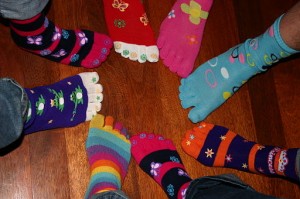
More evidence that low-calorie sweeteners are bad for your health
Studies show that artificial sweeteners can raise the risk of hypertension, metabolic syndrome, type 2 diabetes and heart disease, including stroke.

Poor circulation can lead to a tendency to getting cold hands and feet, which can be an uncomfortable problem during the winter months.
When it’s cold your body automatically draws blood away from the extremities to keep your core and internal organs warm. So when the temperature drops we all need a bit of extra help to keep hands and feet warm.
The first thing to do is review your outerwear. Whether you are exercising, shopping or going to work, winter shoes and socks need to protect your feet from the elements. Go for practical over glamorous every time. If you can’t get away with wearing furry boots in the office, then keep a pair of ‘work shoes’ in your desk and make sure you commute in warm, appropriate footwear.
The same goes for gloves. It can be hard to get into the habit of putting them on when you go out but keeping your hands protected reaps benefits, not only in keeping them warm, but in keeping your skin protected from cold and chapping.
At home you could turn the heat up at home, but it’s healthier (and these days less expensive!) to keep the temperature in your home a bit lower and dress warmly, in thin, adjustable layers, not forgetting the socks and slippers.
You can also turn up the heat from the inside. In traditional Chinese medicine it was considered essential to eat warming foods during the cold season to boost the immune system and prevent winter chills. Adding plenty of fresh ginger and garlic (and if you can take it cayenne) to your cooking is a tasty way of adding warmth to your food.
One of the most effective herbal circulatory tonics is hawthorn, which is used to treat high blood pressure, low blood pressure and arteriosclerosis. Try 160 mg three times per day of a standardised ecxtract. Ginkgo biloba is another well-known circulatory tonic that is especially useful for stimulating the peripheral circulation and so treating cold hands and feet. Hawthorn and ginkgo may be combined to take as a tea or tincture blend but check with an herbalist if you are already on any medication. Try 120 to 160 mg of standardised extract three times a day.
The essential oils of ginger, eucalyptus and juniper are all warming and stimulating to the circulation and will also help to boost the immune system. Add a few drops of each to a vegetable base oil and massage into the skin to create feelings of warmth and to relieve aches and pains and winter chills.
Exercise can improve your circulation by helping smaller blood vessels develop, which can bypass any blockages. Consider also reducing or avoiding caffeine (coffee, tea, chocolate, soft drinks, pain killers, etc.) because it constricts blood vessels. Likewise a regular dry, or if you have access to one far infrared, sauna can help warm you up while removing toxins that can contribute to poor circulation. When you can, practice some form of stress control like biofeedback or meditation. Reflexology, massage therapy, shiatsu, physiotherapy, and different forms of chiropractic and acupuncture could all be helpful.
If you smoke this may be a hint that it’s time to stop. Smokers are more prone to cold extremities because smoking constricts the blood flow to the tiny blood vessels at the tips of fingers and toes. Smokers who quit often see very quick improvement.
Cold hands and feet can sometimes signal Reynaud’s disease. This inherited autoimmune condition affects between 3% and 20% of the adult population. It affects mostly women and can appear at any age. The blood supply to fingers and toes (and sometimes ears and nose) is interrupted, making them go white and become very painful. There’s no cure, prevention (such as thermal gloves) is vital, but if your condition seems to be getting worse it’s worth consulting a healthcare practitioner for a definitive diagnosis and to rule out any other health problems that might be associated with cold extremities.
Finally practitioners of the Buteyko method of breathing say that a simple breathing exercise can help improve circulation and warm both hands and feet within 2-3 minutes.
The method involves sitting in a chair with your spine straight and relaxing all your muscles. Begin by taking a slightly smaller (about 10% less) breath than normal. As you exhale relax all your muscles, especially those in the upper chest and other breathing muscles. Take another (smaller) breath and again completely relax.
The goal of this exercise is to gradually reduce the amount of air you take in with each breath, until you experience alight but comfortable ‘air hunger’. Done correctly, maintaining this light air hunger for 2-3 minutes should warm up your hands and feet completely. If you suffer from heart disease, hypertension, migraine or panic attacks do not push yourself – go more slowly in reducing your air intake and never go past a level at which you feel comfortable.
For patients with advanced Raynaud’s disease, it may take longer time, up to 1-2 weeks, and more practice, to improve circulation, regulate breathing and improve symptoms.
If you get cold hands and feet at night in bed try lying on your left side or on chest and relax all your body muscles. Breathe only through the nose. Follow the instructions above for reduced breathing to get quick relief.

Please subscribe me to your newsletter mailing list. I have read the
privacy statement